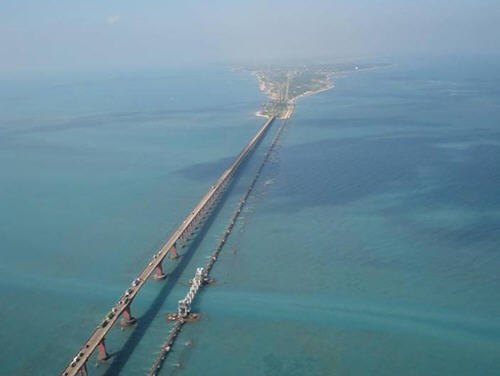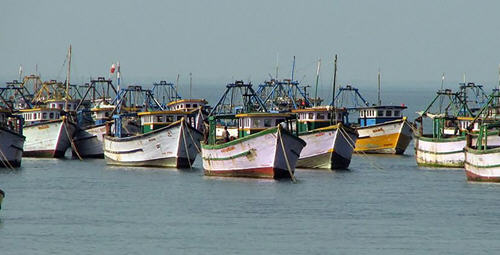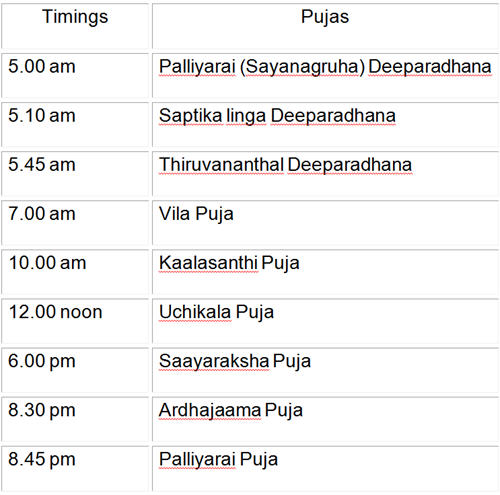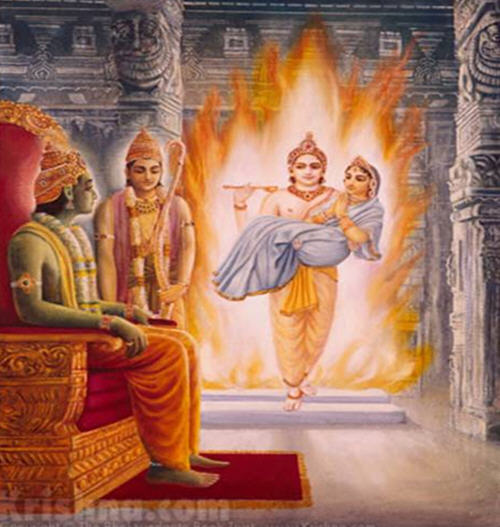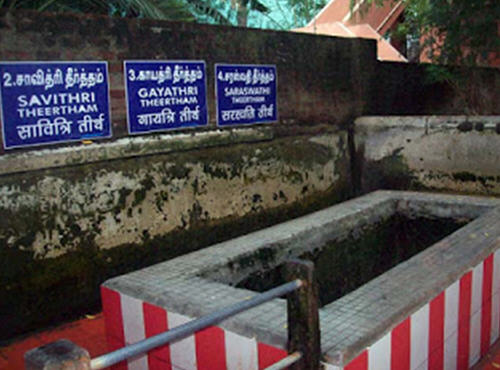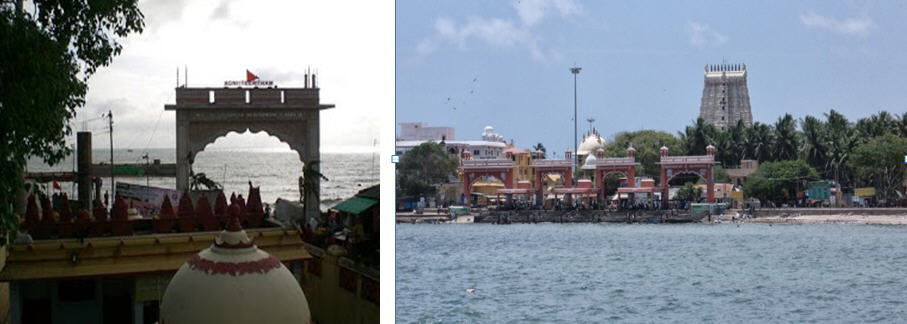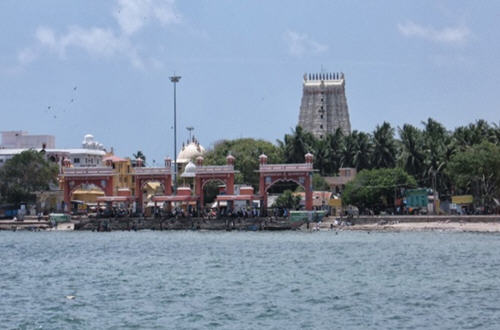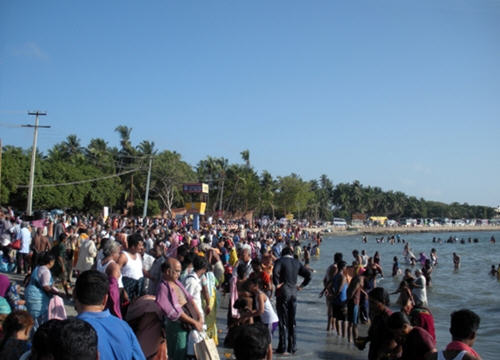1) The Gandamadhana parvat (hill) provides a commanding view of the island. It also bears a shrine said to bear the footprints of Lord Rama. Lord Rama along with his monkey generals stood here for a view of the area and His plan-making.
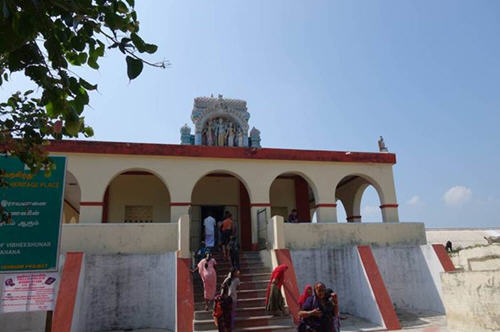
2) Dhanushkodi Tirtham or Dhanushtirtha is located at the eastern end of the Rameshwaram island. It is named after Lord Ramacandra’s bow and is at a distance of 18 km from Rameshwaram temple. The boulders in the sea between Sri Lanka and Dhanushkodi are known as Adam’s bridge. Lord Rama used them to reach across Lanka. The sethu (bridge) that was built by the monkey soldiers was 80 miles wide and 800 miles long. On the first day of the construction of the bridge, they covered 100 miles and the next day they completed 150 miles. Within five days they built a seamless and perfectly symmetrical bridge. The entire bridge was 800 miles long and 80 miles wide.
After Ravana was killed, Lord Ramacandra along with His army returned to Rameshwaram. At that time Vibhisana approached Lord Ramacandra and requested Him that “this beautiful sethu (bridge) which we have built is so good, but it gives easy access to Lanka and in future some demoniac kings may attack Lanka or some rakshasa may come over and cause disruption here. So please break this bridge”. So upon the request of Vibhisana, Lord Ramacandra took His bow and with one end of the bow He cut the bridge into three parts and the bridge was destroyed. The two oceans (Bay of Bengal and Indian ocean) which were separated by the bridge, merged together. 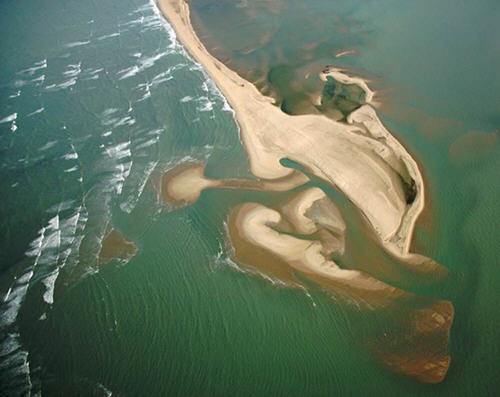
Sri Ramacandra called for all the holy waters and tirthas of the entire universe to enter into Dhanushkodi Tirtham. All the heavenly tirthas personified came there and filled up the sea where the bridge was broken. The place is so beautiful that Lord Ramacandra and Sita devi bathed here. Lord Rama said, “Anyone who comes here will be liberated from material bondage and We will shower Our mercy on them.” Sri Caitanya Caritamrta Madhya Lila Chapter 9 verse 199 mentions that Lord Sri Caitanya Mahaprabhu came to Dhanushkodi Tirtham during His South India tour and took bathe here.
In 1964 this place was struck by a cyclone and was completely washed away. Now days, Dhanushkodi is a strip of land about 1 km wide and 18 km long on the eastern end of Rameshwaram island. On one side are the waters of the Indian Ocean and on the other the waters of the Bay of Bengal. The two seas otherwise known as Ratnakaran and Mahodadhi with their confluence is shaped like a bow while the strip of land resembles an arrow poised for release. It is a place where the rough water of Indian Ocean and the calm sea of Bay of Bengal confluence together. Before 1964, this was a flourishing place with r ailway station called Ramnad (last station on Southern Railway), hospital and port for many ferry services between Dhanushkodi and Talaimannar in Sri Lanka. Currently mute evidences remain in this place.
Danushkodi is about 18 miles West of Talaimannar in Jaffna, Ceylon. Before 1964 storm there was a train service up to Danushkodi called Boat Mail from Chennai Egmore station. The train linked a steamer to Ceylon. During the 1964 storm a huge wave of about 20 feet came crashing on the town from Palk Bay/Strait east of the town and destroyed the whole town, a train, the Pamban Rail Bridge etc. Danushkodi has the only land border between India and Ceylon which is one of the smallest in the world just 50 yards in length on a sand dune in Palk Strait. Buses from the local bus stand on East Car Street stop about 4km before the beach.
Way to Dhanushkodi Tirtham
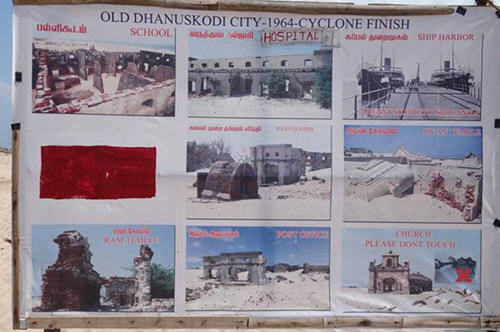
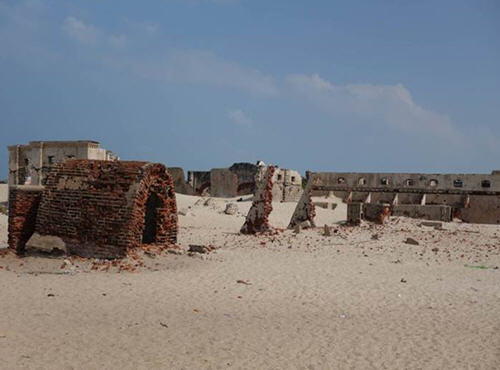
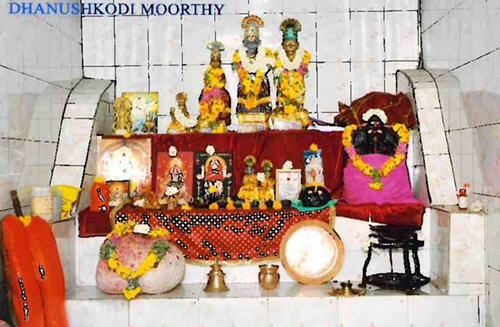
Picture of Deities at Dhanushkodi Tirtham Ruins at Dhanushkodi from 1964 cyclone
3) Kothandarama Swamy Temple is located 12 km away from Rameshwaram. Here Lord Ramacandra arranged for the coronation of Vibhisana as King of Lanka after his surrender. The walls of Kothandarama Swamy Temple are adorned with marvelous paintings that depict the story of Ramayana.
Historyof Vibhisana’s surrender
When Ravana’s spies headed by Saardula reported to him that there are countless monkeys assembled on the shore across the ocean, Ravana decided to have special war council. He called all his generals and commanders and explained the situation to them. Ravana said, “A first class leader does not make a decision without consulting, with open mind, wise experienced ministers, friends who have been faithful throughout life and family members who have proven their love and after taking that council and seriously considering every word of it depending upon the higher power of God or providence for right direction. A second class leader with his own intelligence searches his own heart what’s best to do and then after considering everything takes full responsibility. A third class leader is one who hastily attacks or does something serious without due consideration of the pros and cons.”
The ministers were very enthusiastic. One by one they stood up, raised their weapons and began to glorify Ravana and their own prowess. They were hungry for war. Finally Vibhisana stood up and spoke the truth. He said, “In the battle the virtuous are empowered to have ultimate victory and the sinful are doomed to defeat. Ramacandra is supremely virtuous and rakshasas are sinful. We cannot stand before Him. These men are not your friends. All of these generals are simply telling you what you want to hear and not speaking the truth.” Vibhisana then told Ravana about Khar and Dushana, when they attacked Ramacandra. Lord Ramacandra single handedly destroyed their entire army of 14,000 soldiers in just 2 hours. He is not a mortal, Ramacandra is the Supreme Lord and His wrath can destroy the whole universe.
Vibhisana said, “Stealing Sita devi was sinful. Please return Sita devi to Ramacandra or we will perish. Ramacandra will forgive you. Just beg forgiveness and return Sita otherwise you and your entire dynasty will be destroyed and you will be the cause of it.” Next day morning Vibhisana again went to meet Ravana and again tried to counsel him Ravana was very disturbed. He said to Vibhisana, “Why do you question my prowess. No one can defeat me. I will defeat Rama. Single handedly I can wipe out the entire monkey army. Why do you question me? I cannot give Sita. There will be war.” Vibhisana was devastated. There is nothing else he could do. But still he was going to try.
Ravana then called all his greatest war generals in the assembly hall. He told them that his heart has been captivated by Sita and he cannot give her up. He told them a lie. He said that Sita promised him that if Rama does not come to take her away within a year then she will be mine. Someone told him that you have strength of thousands of elephants and Sita is just a little girl, why don’t you enjoy her by force. Ravana then revealed a secret, once he was infatuated by seeing the beauty of heavenly damsel Rambha. He chased after her and forcibly enjoyed her. She went to her husband Nalakuvera. He was so devastated that he cursed me that if I ever try to enjoy any woman without her independent consent, then my head will break into hundreds of pieces. Lord Brahma confirmed this curse upon me. So I cannot enjoy Sita by force. She has to submit to me and she will never submit to me till she has hope that Rama will come to rescue her. Hearing this all the generals gave their full support to Ravana and agreed for war.
At that time Vibhisana stood up and said, “Who has put this venomous serpent around you. Sita is like a serpent; Her charming smile her fangs; Her shapely form is her coils; Her caste faithful love for Lord Ramacandra is like the venomous poison that is going to be the cause of your death. Give up Sita and live. By fighting with Rama you are putting a noose around your own neck.” At that time Indrajit began to brag about his prowess. Vibhisana chastised Indrajit. When Ravana heard Vibhisana chastising his son, he became furious. He stared into his eyes and said, “It is better to live with a venomous snake then with someone who is taking the shelter of your enemy.” He then rejected Vibhisana and asked him to get out of Lanka.
Lord Sri Krishna says in Bhagavad-Gita, within every heart there is a divine and the demoniac nature by the choices we make and by our own seriousness in our spiritual practice we are meant to cultivate and give strength to our divine nature and subdue this demonic nature that is within us.
Shurpanakha wanted to enjoy Rama and kill Sita devi, Ravana wanted to enjoy Sita and kill Rama and Vibhisana wanted to return Sita to Rama and offer loving devotion. They are living in the same place. In a similar way in our own hearts we have Shurpanakha’s tendencies, Ravana’s tendencies and deep down we have our eternal natural Vibhisana’s tendencies. We can cleanse the heart of the anarthas of Ravana and Shurpanakha by taking shelter of Lord Himself and in this age of Kali the Lord is there to annihilate these demons within and empower the divinity within us by the chanting of the holy names.
After being chastised by Ravana, Vibhisana and his four faithful ministers ascended in the sky. From there he looked down and spoke these final words to his brother, “I have honestly tried to help you. But I cannot tolerate harsh words against me, nor can I tolerate your sinful attachment to Sita. On this very day I am going to leave behind my family, wealth and everything I have and I renounce you.
Sugriva and other monkey soldiers saw Vibhisana and his four ministers in the sky and were about to attack them. Vibhisana said that he had come to take shelter of Lord Ramacandra. Sugriva went to Lord Rama and informed him about Vibhisana. Lord Rama asked them what He should do with Vibhisana. Sugriva said, they are demons, by nature they are deceitful and they cannot be trusted. Jambavan had similar opinion. Finally Lord asked Hanuman for his opinion.
Hanuman said, “Vibhisana is honest. While in Lanka he was constantly advising Ravana to give back Sita devi. We should immediately accept him to be one of our family members. He wants shelter, please give him shelter.” Lord Ramacandra very much appreciated Hanuman’s words.
Lord Rama’s vow : Lord Ramacandra then spoke His immortal words, “Anyone whoever they may be, who sincerely take shelter of Me and honestly says, even once, that from this day on my Lord I take Your shelter, I have to give him shelter. I declare this vow before all of you. Even if Ravana himself were to come to me today and with a sincere and honest heart seek shelter of Me, I will give him shelter.”
Upon hearing this all the monkeys were weeping in ecstasy to see the nature of lord Ramacandra’s mercy. They all shouted “Jai Sri Rama”.
What it really means by surrender. It is not just our words. To take shelter means to sincerely repent for one’s past misgivings, to vow to give up one’s misbehavior and to give one’s heart and take shelter of the Lord who has appeared in His holy names:
Hare Krishna Hare Krishna Krishna Krishna Hare Hare |
Hare Rama Hare Rama Rama Rama Hare Hare ||
Then Vibhisana came down from the sky and surrendered his life to Lord Ramacandra. Rama told him that in days to come He will conquer Ravana and he would be the future king. Lord then coronated Vibhisana as the king of Lanka here – Kothandarama Swamy Temple. Lord Ramacandra asked Vibhisana, how to cross the ocean and Vibhisana told Him that He should ask Samudradev for help.
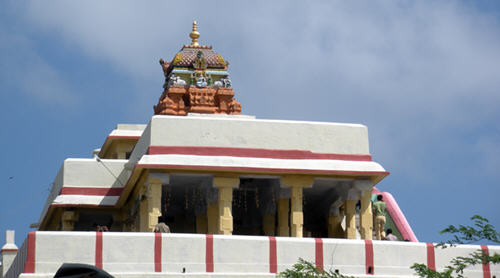
Meanwhile Ravana sent Shuka to somehow convince Sugriva to give up Rama’s side. When Shuka came in the form of a bird and delivered this message, all the monkeys became enraged and they started beating him. Shuka cried out for Rama and Rama called for him. Rama said, he has taken shelter of Me. Release him. Shuka went back and told Ravana what had happened and requested him that he should better give Sita devi back or else Lanka will be destroyed.
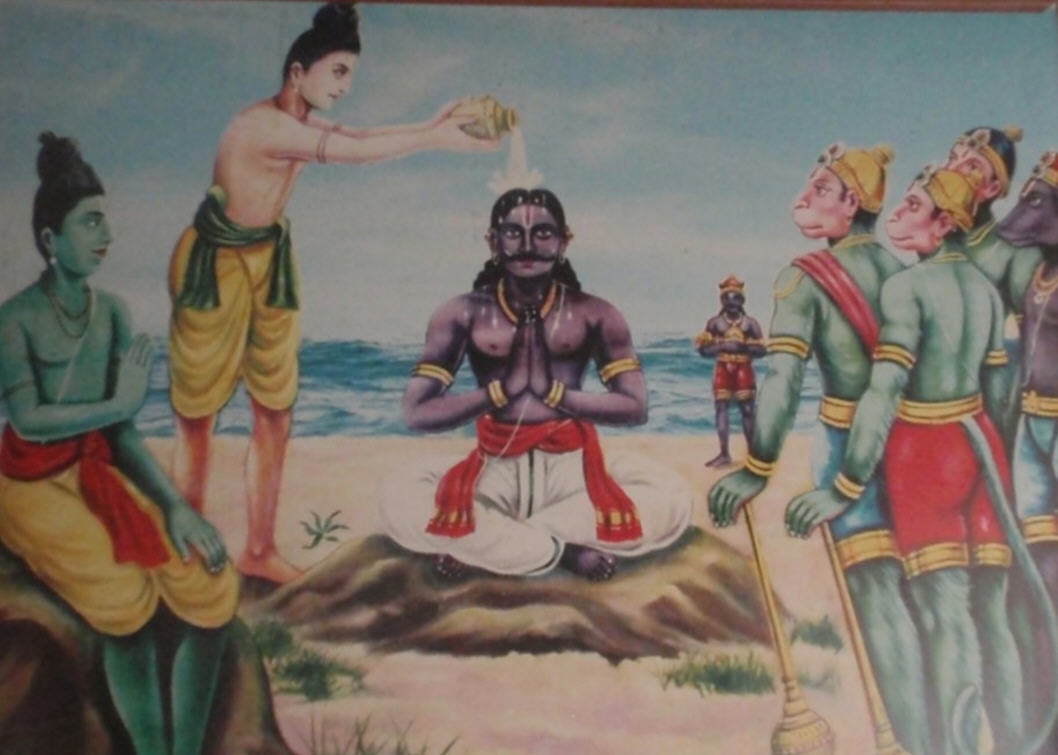
4) Bilondi tirtha is an amazing place. It is said that Lord Rama struck an arrow in the sea to satisfy Mother Sita’s thirst and a fountain of pure water appeared at this place in the midst of the salty sea. Sita devi drank the water and was satisfied. This well is still there within the sea and is connected by narrow walking bridge which leads to the well. This place is located 6 kms on the main road connecting Ramanath Swamy temple to Pamban bridge. It is 15 minutes walk off the main road. On the main road, you will also find Ekantha Rama temple – where locals say Lord Rama spent some time in seclusion.

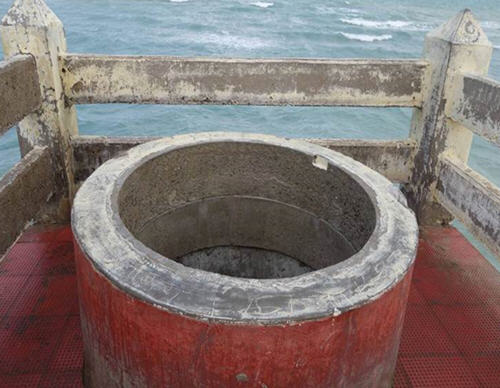

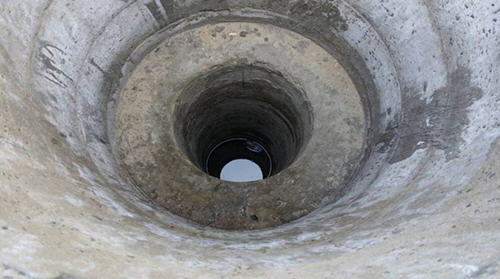
5) Sri Ekantha Ramaswamy Temple is about six km from Rameshwaram Temple on the main road connecting to Pamban. This is the place where Lord Ramacandra spent some time in seclusion. The temple has also a well which was used to quench the thirst of monkey soldiers of Lord Rama.
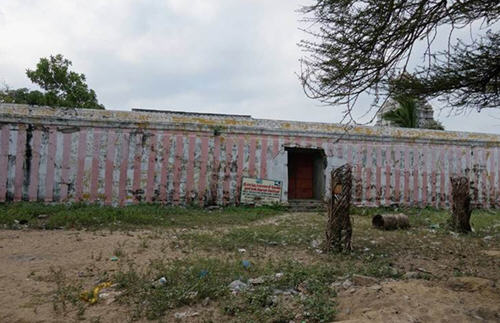
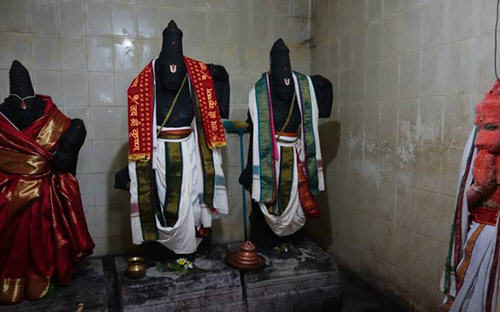
6) Rama Tirtham, Lakshman Tirtham and Sita Tirtham – located nearby each other and very close to Ramnath Swamy temple are around 1 km walk on main road. Rama Tirtam is the place where Lord Ramacandra took rest for a while on His way to Lanka. This is close to Rameshwaram temple about 1 km walk from Rameshwaram Temple.
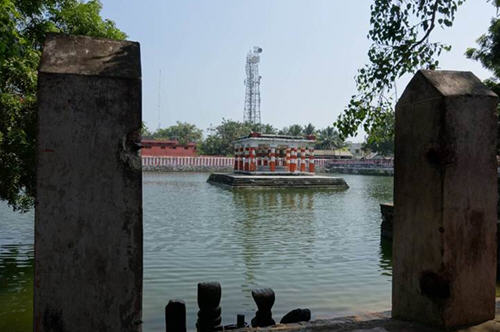
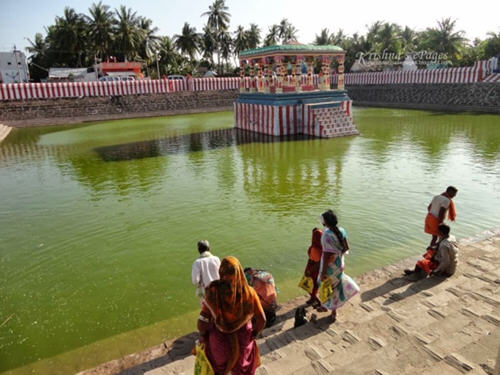
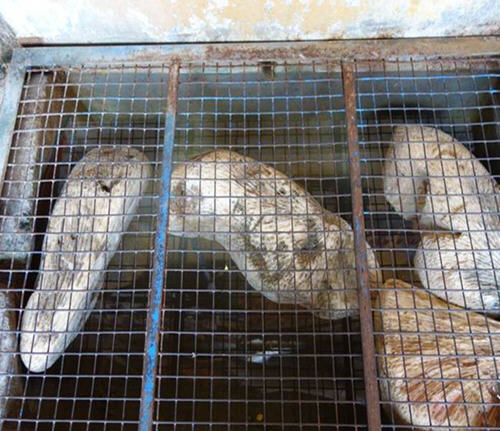
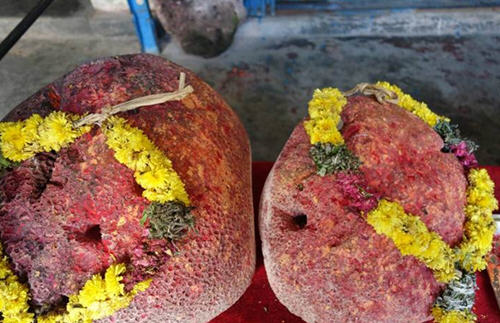
Picture of Floating rocks that were used by the monkey army of Lord Ramacandra for building sethu (bridge) across to Lanka
6) Jada Tirtham is on the way to the Dhanushkodi Tirtham while going from Rameshwaram. Lord Ramacandra washed His hair (Jada) in this tirtham on the way back after He killed Ravana so as to purify Himself before commencing the pooja for Siva linga.
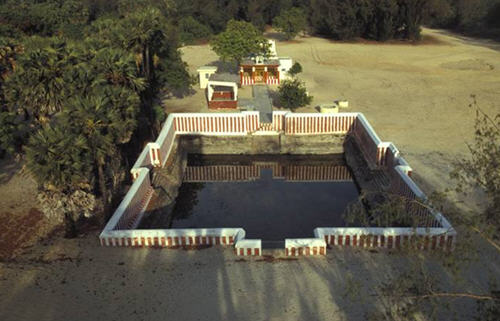
7) Pamban Bridge :-
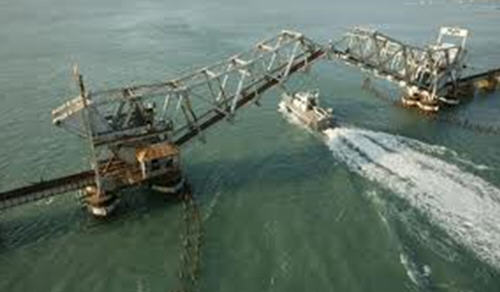
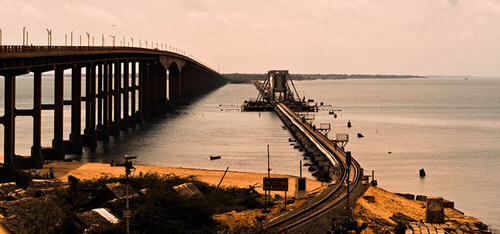
Rameshwaram is an island which was connected by the main land with the help of Boat services from Mandapam on early days. Now day’s two famous Bridges which connect Rameshwaram and Mandapam viz the bow shaped Road Bridge and cantilever Railway Bridge are the eye attractions of anyone passing through.
The Pamban Bridge is a cantilever bridge on the Palk Strait which connects Rameshwaram on Pamban Island to mainland India. It refers to both the road bridge and the cantilever railway bridge, though primarily it means the latter. It was India’s first sea bridge. It is the second longest sea bridge in India (after Bandra-Worli Sea Link) at a length of about 2.3 km. The railway bridge is 6,776 ft (2,065 m) and was opened for traffic in 1914. The railroad bridge is a still-functioning double-leaf bascule bridge section that can be raised to let ships pass under the bridge.
Road Bridge: The engineering marvel of this bridge took 14 years to complete. Inaugurated in 1988, it is designed like a bow over the sea to allow ships to pass beneath. The bridge is 2.03 km long and is supported by 79 pillars (64 of which are built in the sea). This bridge is also known as Pamban Bridge or Annai Indira Gandhi Bridge.
Rail Bridge: this bridge was built during 1913 and is 2.06 km long. A portion of the bridge opens up like a pair of scissors to let the ship pass under it
. 